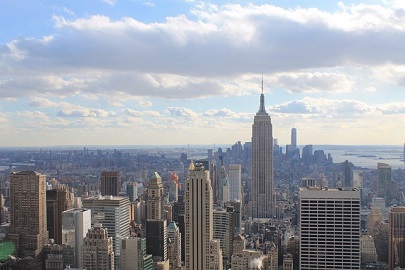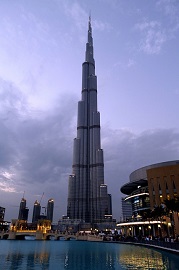Skyscraper
To help develop this article, click ‘Edit this article’ above.
Contents |
[edit] Introduction
The term ‘skyscraper’ refers to tall, continuously habitable buildings of 40 floors or more. Throughout the history of the built environment, skyscrapers have been developed as prestigious structures demonstrating the power and wealth of a city or nation and producing a sense of wonder.
Although the term ‘skyscraper’ was only coined in the late-19th century – to describe buildings of steel-framed construction of at least 10 storeys – the desire for tall and impressive buildings extends back to the Pyramids of Giza in Egypt and the cathedrals built across Europe. The tall structures built throughout the Middle Ages were intended to fulfill the religious function of acquiring a better connection with the gods, or the military function of enabling a good vantage point.
The development of more modern construction techniques began with the arrival of the Industrial Revolution. Two specific innovations in the 19th century made skyscrapers much more practical:
- In 1857, lifts or elevators meant that building height was no longer such a concern to occupants in terms of safe passage between floors.
- The introduction of iron frame and glass curtain wall construction instead of stone or brickwork meant that buildings could be designed to be much taller than before.
Skyscrapers are also a feature of urbanisation. From the 19th century onwards, cities started becoming denser, creating the necessity for building upwards to maximise floor space efficiency. Today, skyscraper construction is still largely dictated by economics, with the price and availability of urban centre land justifying building upward.
[edit] Early skyscrapers
- Although only 5 storeys tall, the Oriel Chambers in Liverpool, built in 1864, was the first building in the world to use an iron frame and glass curtain wall construction which enabled greater load-bearing capabilities.
- In 1885, the Home Insurance Building in Chicago was completed and is widely recognised as the first skyscraper, despite being only 10 storeys (42 m) tall.
- In 1889, Chicago’s Rand McNally Building became the first all-steel framed skyscraper.
- In 1891, St Louis’ Wainwright Building became the first steel-framed building with soaring vertical bands to emphasise the building’s height.
- In 1895, New York’s American Surety Building secured the title of world’s tallest skyscraper (21 storeys).
- While height restrictions were implemented across Europe in the early-20th century, New York and Chicago led the way in skyscraper construction.
- In 1902, the Flatiron Building (20 storeys) was built, and is now one of the most iconic examples of the New York skyscraper boom. This boom saw the completion of the Metropolitan Life Insurance Tower (50 storeys), the Woolworth Building (60 storeys), the Bank of Manhattan (71 storeys) and the Chrysler Building (which, upon completion in 1930, was briefly the world’s tallest building at 77 storeys).
- In 1931, New York’s Empire State Building was completed. At 102 storeys (381 m) tall, it stood as the world’s tallest building for the next 40 years.
[edit] Modern skyscrapers
As buildings became ever taller, the techniques and methods of construction changed. Steel beam grids and columns were utilised. Concrete steel and glass were used for their strength, durability, and resistance to the weather. To try and alleviate the risk of wind sway, engineers began installing diagonally-braced steel trusses to ensure a stronger core.
Throughout the 1960s, the structural engineer Fazlur Khan developed a new method of skyscraper construction. He moved most beams and columns to the outside walls, and in so doing creating a stiff tube that offered greater structural stability.
- In 1972, the World Trade Center (415 m) became the world’s tallest building and was an early adopter of Khan’s construction methods.
- In 1973, Chicago’s Willis (or Sears) Tower (100 storeys, 442 m) was completed.
- Over the next decades, the skyscraper boom spread into Asia, South America and Europe, culminating in Malaysia’s Petronas Towers becoming the tallest skyscraper in 1998 (452 m), followed by Taiwan’s Taipei 101 in 2004 (509 m).
- Since 2010, the tallest building in the world has been Dubai’s Burj Khalifa (828 m).
For more information see: Tallest buildings in the world.
[edit] Related articles on Designing Buildings
- 7 Engineering Wonders of the World.
- Buildings of a great height IGH.
- Citigroup Center.
- Densification.
- Empire State Building.
- Flatiron Building.
- Groundscraper.
- High-rise building.
- Lifts.
- One Park Taipei.
- Megastructure.
- Megatall.
- Outrigger.
- Plug and play skyscrapers.
- Supertall.
- Super-slender.
- Tall building.
- Tallest buildings in the world.
- The history of fabric structures.
- The skyscrapers of the future will be made of wood.
- Top 10 skyscrapers located in the UAE.
- Tower.
- Twisting buildings.
- Types of building.
[edit] External references
- Museum of the City - A brief history on the development of skyscrapers
- SkyscraperPage
- Skyscrapers
Featured articles and news
RTPI leader to become new CIOB Chief Executive Officer
Dr Victoria Hills MRTPI, FICE to take over after Caroline Gumble’s departure.
Social and affordable housing, a long term plan for delivery
The “Delivering a Decade of Renewal for Social and Affordable Housing” strategy sets out future path.
A change to adoptive architecture
Effects of global weather warming on architectural detailing, material choice and human interaction.
The proposed publicly owned and backed subsidiary of Homes England, to facilitate new homes.
How big is the problem and what can we do to mitigate the effects?
Overheating guidance and tools for building designers
A number of cool guides to help with the heat.
The UK's Modern Industrial Strategy: A 10 year plan
Previous consultation criticism, current key elements and general support with some persisting reservations.
Building Safety Regulator reforms
New roles, new staff and a new fast track service pave the way for a single construction regulator.
Architectural Technologist CPDs and Communications
CIAT CPD… and how you can do it!
Cooling centres and cool spaces
Managing extreme heat in cities by directing the public to places for heat stress relief and water sources.
Winter gardens: A brief history and warm variations
Extending the season with glass in different forms and terms.
Restoring Great Yarmouth's Winter Gardens
Transforming one of the least sustainable constructions imaginable.
Construction Skills Mission Board launch sector drive
Newly formed government and industry collaboration set strategy for recruiting an additional 100,000 construction workers a year.
New Architects Code comes into effect in September 2025
ARB Architects Code of Conduct and Practice available with ongoing consultation regarding guidance.
Welsh Skills Body (Medr) launches ambitious plan
The new skills body brings together funding and regulation of tertiary education and research for the devolved nation.
Paul Gandy FCIOB announced as next CIOB President
Former Tilbury Douglas CEO takes helm.
UK Infrastructure: A 10 Year Strategy. In brief with reactions
With the National Infrastructure and Service Transformation Authority (NISTA).

























Comments
There are a ton of spelling errors.
Do you mean ton or tonne?
There are differences between the UK English and American English versions of some of the words used, but there are no spelling errors.